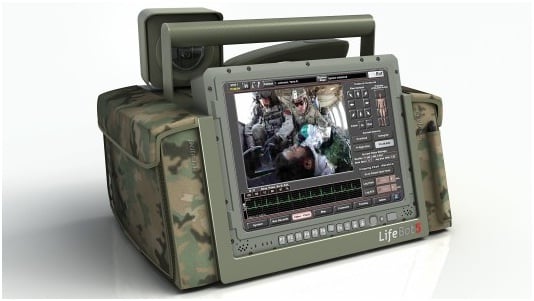Telemedicine is the use of medical information exchanged from one site to another via electronic communications to improve patients' health status. Closely associated with telemedicine is the term "telehealth," which is often used to encompass a broader definition of remote healthcare that does not always involve clinical services. Videoconferencing, transmission of still images, e-health including patient portals, remote monitoring of vital signs, continuing medical education and nursing call centers are all considered part of telemedicine and telehealth.
When it comes to medical emergencies, time doesn’t mean money, it means lives. The quickness with which information can be communicated between where the patient is and where the doctor is in some circumstances could determine a patient’s life.
LifeBot is a telemedicine unit that connects ambulances to hospitals with patient data and live video feeds. The newest version, LifeBot 5 is a more portable, more rugged unit that is no longer confined to the ambulance. It can be carried directly to where the patient is. LifeBot 5’s Interceptor is a medical electronics module that enables full physiological monitoring of the patient. It is also equipped with Electronic Patient Call Report (ePCR), which is a Web browser interface that provides access to Electronic Health Record systems.

Web Real-Time Communication (WebRTC), is an API being drawn up by the World Wide Web Consortium which enables Web browsers with real-time communications capabilities via Javascript APIs. WebRTC is likely to change communications in healthcare. WebRTC will lead to quicker communication and therefore faster decisions. Tie this in with having a LifeBot 5 on location and it is almost like having a doctor there with the EMS.
It is easy to call 911 from home or your mobile phone, but sometimes if there is an emergency at work and you have to go through the company PBX system, you may have problems. That is why E911 is an important consideration for businesses. If you cannot call for an ambulance it doesn’t matter what equipment they are carrying.
Once the ambulance arrives if immediate information for proper treatment is needed, the LifeBot 5 can be there with the patient. It uses a secure 4G, 3G, LTE, WiMax, cellular, Wi-Fi, satellite and/or data radio connections to send data. The device automatically selects whatever system(s) work best for the given location. The response time is only a few seconds.
It is not surprising that the original version was developed using Department of Defense grants. These came from the Telemedicine and Technology Research Center and U.S. Army Medical Research and Material Command. What this gave us was the LifeBot 5, a device that could be used to shorten the response time for patient care in the field.
Edited by
Brooke Neuman